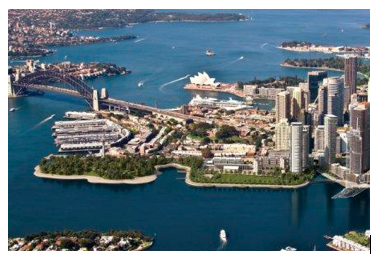 Both physical and mental health have become a focus for urban planning and development from 2007 when the world’s urban population overtook it’s rural population for the first time in history. The importance of green space has been, at last, recognised as a factor towards improving public health and wellbeing and has been reported in a number of research documents.
Both physical and mental health have become a focus for urban planning and development from 2007 when the world’s urban population overtook it’s rural population for the first time in history. The importance of green space has been, at last, recognised as a factor towards improving public health and wellbeing and has been reported in a number of research documents.
It is with this in mind, that the development of the proposed Barangaroo Headland Park on Sydney Harbour is given the specification of being as natural as possible. In contrast to the more formal gardens in other nearby gardens, the design brief states that this park must include the plant species of the local area and appear to be a natural forest reproduced in the middle of the city.
The physiological benefits of greenspace show a drop in heart rates and blood pressure, whether the person is physically in the natural setting or simply viewing it from a window. Natural environments can also have positive impacts on job performance and satisfaction, as well as reduced office stress rates and absenteeism. So it’s clear that the design brief is “on the money” …. in more ways than one. The park will bring many visitors and recreation activities to the harbour foreshore, along with significant tourism dollars.
It’s a tall order to fill, when you’re looking at building a garden on top of a huge slab of concrete, 6 hectares of parkland, actually.
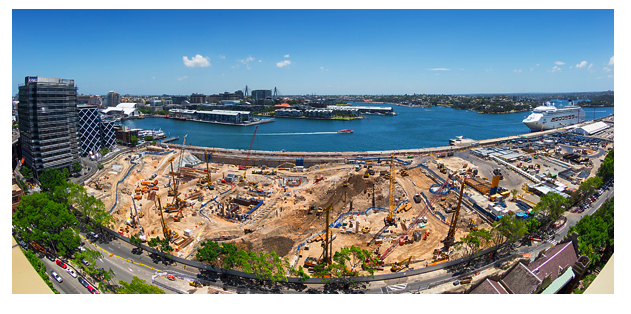
According to specifications, the manufactured “soil” will need to reach a depth of 18 metres and some 90, 000 plants will need to be grown for the project, including 700 trees. So, it was with great interest that I attended the Australian Institute of Horticulture’s seminar with the respected horticulturist and landscape architect, soil scientist and grower who are overseeing this major project. It is a project that could change the face of our city.
Stuart Pittendrigh, is the horticultural consultant charged with specifying the plant species to suit the area. Working with the design team, Pittendrigh examines early records held at the Royal Botanic Garden in Sydney to determine the endemic species that resided in the area long before it was overtaken by city skyscrapers. He retains the integrity of the region well, with the exception of only a few species whose origin is just outside the harbour region (including Gymea Lily and Corymbia maculata) for which he can be forgiven. He uses nature as a guide to choose the understory species for the forest areas, found in their natural plant communities, then maintains their companionship.
What intrigued me was the requirement of the designers for super advanced plants from day 1. I understand the desire for an instant parkland, but nature takes many decades to produce this “effect”. The horticultural difficulties of providing this is a real challenge for the growers and installation team.

The natural appearance of the specimen plants goes against many of the usual nursery and growers’ definitions of a “good plant”. The usual straight trunks and symmetrical forms are not needed for this project, but misshaped trees that are destined for removal by some councils are eagerly sought after. It’s the multi-trunk of some trees and lopsided canopy of others that don’t suit regular formal plantings, but rather, give a “natural form” and become desired specimen plants for the Barangaroo site. It is a lovely sense of sustainable stewardship with the transplanting of these aged trees into their eventual new home.
Some interesting facts were revealed by Tim Carroll, of Andreasen’s Green Wholesale Nursery, the project production manager responsible for growing all the plants for the new site. Andreasen’s have been given 2 years to grow and provide the entire planting. A special nursery was set up specifically for this purpose and was chosen for it’s similarity with the headland’s specific conditions. It is just north of Sydney at Mangrove Mountain; a site also on Hawkesbury sandstone soil, experiencing windy conditions and high precipitation.
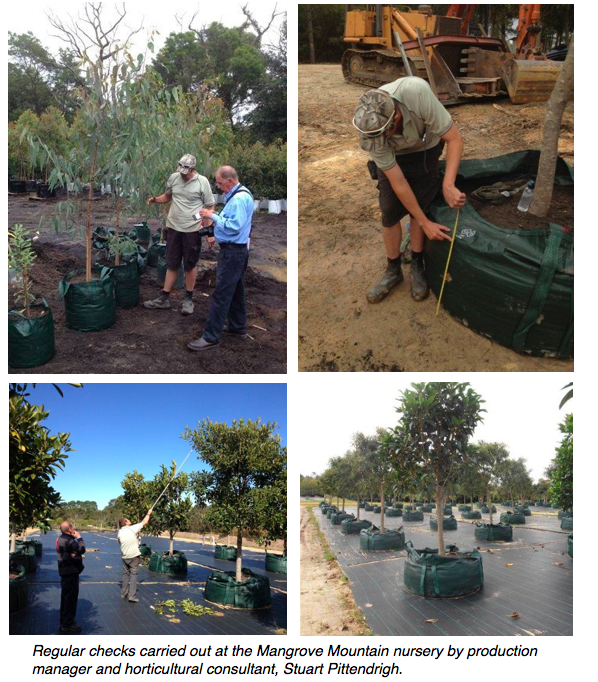
The 63 Ficus macrophylla are given “double spacing”, much further apart than in most wholesale nurseries, to allow for sun hardening and opportunity to handle exposure to harsh conditions. These trees have been dug up from southern Queensland and containerised into suitable nursery growing bags with 2000ltr capacity.
Mature palms have been dug up, transported to the Mangrove Mountain nursery and then replanted in the ground here. The palms have a compact fibrous root system which adapt well to being transplanted. They will be transplanted again to the final site when installation begins in early 2014.

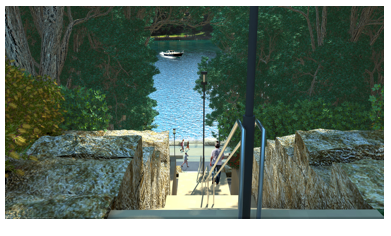 The site for the Barangaroo Headland Park has quite a steep slope and a number of terraces are included in the landscape design. The terraces are accessed by steps, making certain areas of forest difficult for disability access. The walkway around the entire park along the water’s edge is, however, fully wheelchair accessible. Terracing is essential to hold the soil (up to 18 metres deep in some areas) and effectively grow the chosen plants as well as handling the foot traffic of the expected high volume of visitors.
The site for the Barangaroo Headland Park has quite a steep slope and a number of terraces are included in the landscape design. The terraces are accessed by steps, making certain areas of forest difficult for disability access. The walkway around the entire park along the water’s edge is, however, fully wheelchair accessible. Terracing is essential to hold the soil (up to 18 metres deep in some areas) and effectively grow the chosen plants as well as handling the foot traffic of the expected high volume of visitors.
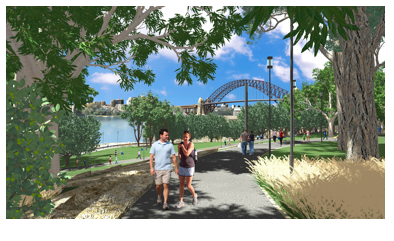 Simon Leake from SESL is the soil scientist for the park and is responsible for delivering a soil that will closely simulate the real Hawkesbury sandstone soil that originally existed at the site. A facsimile soil will be made to replicate the soil at Mangrove Mountain to ensure natural tree development and good plant growth. Simon shares his soil testing procedures so far and sheds light on the extremely low fertility levels of the natural forest. The soil at the park will be a 2-layered construction using crushed sandstone substrate with a top layer of sand-sandstone-recycled organics mix for the growing media. The soil tests were conducted on varying percentages of composed green waste from ANL at 30%, 10% and 5% organic material, while pH was adjusted to determine toxicity or chlorosis levels in plant tissue. The overall finding is that the soil was too rich at 30% organic mix, so the facsimile soil used will use as little as 5-10% organics and have a pH less than 7 for healthy plants.
Simon Leake from SESL is the soil scientist for the park and is responsible for delivering a soil that will closely simulate the real Hawkesbury sandstone soil that originally existed at the site. A facsimile soil will be made to replicate the soil at Mangrove Mountain to ensure natural tree development and good plant growth. Simon shares his soil testing procedures so far and sheds light on the extremely low fertility levels of the natural forest. The soil at the park will be a 2-layered construction using crushed sandstone substrate with a top layer of sand-sandstone-recycled organics mix for the growing media. The soil tests were conducted on varying percentages of composed green waste from ANL at 30%, 10% and 5% organic material, while pH was adjusted to determine toxicity or chlorosis levels in plant tissue. The overall finding is that the soil was too rich at 30% organic mix, so the facsimile soil used will use as little as 5-10% organics and have a pH less than 7 for healthy plants.
The name of the site was chosen after a state wide competition in 2006. “Barangaroo” was a powerful indigenous woman who was Bennelong’s second wife. Bennelong, being a famous indigenous person who interacted closely with the early white settlers, also has his name attributed to the harbour foreshore at Bennelong point where the Sydney Opera House is now located.
For the tourist with only a couple of days to spare in Sydney, the Barangaroo Headland Park will provide a walk through an Australian sclerophyll forest that is true to Sydney harbour, without the need to even leave the city. A cultural centre is proposed for the site and is the only “building” for the project. This will be available for visitors as an education centre about the local vegetation and function rooms will be hired for special events on the harbour foreshore.
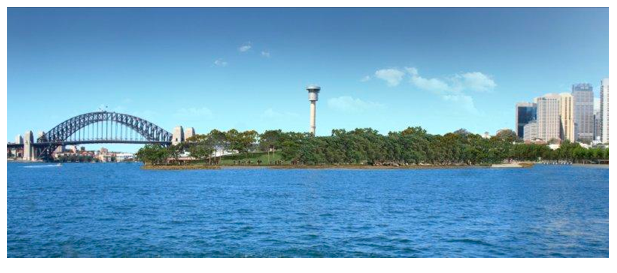
The Barangaroo Headland Park is due for completion in September 2015.
Photos are courtesy of Tim Carroll from Andreassons Green and the Barangaroo website www.barangaroo.com




 Twitter
Twitter Facebook
Facebook